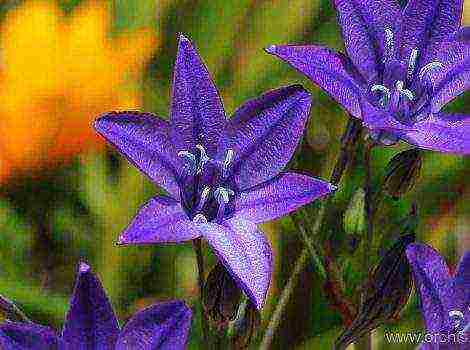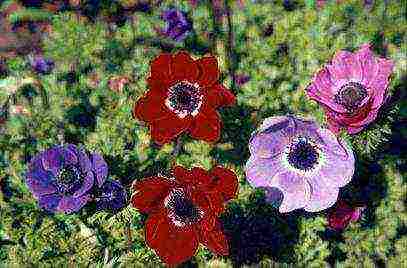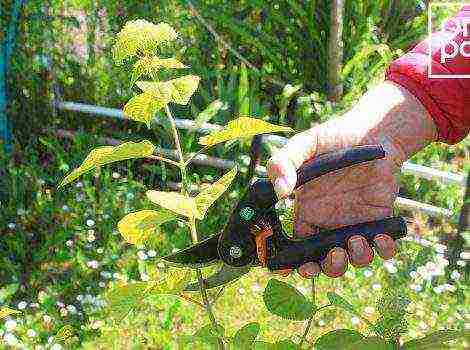Content
- 1 Soil preparation
- 2 Description of anemone flower
- 3 What does a flower look like?
- 4 Types and varieties of culture
- 4.1 Japanese anemone - elegant and bright
- 4.2 Japanese varieties
- 4.3 Crown anemone
- 4.4 De Caen - a mix of colors and shades
- 4.5 Saint Bridget - terry splendor
- 4.6 Mount Everest - the whiteness of the mountain peaks
- 4.7 Admiral's grade
- 4.8 Delicate creation
- 4.9 Blue Shades is the most delicate of the gentle
- 4.10 Bicolor anemone
- 4.11 Variety Lord Lieutenant
- 4.12 Sylphide variety
- 5 Landing rules and care features
- 6 Indoor cultivation of anemones
- Anemone Sem. buttercup (Ranunculaceae).
- A. crown (A. coronaria L.). Blooms from June to October. Refers to ephemeroids - geophytes. Has a short rest period.
- In culture, it retains its characteristics of early spring growth and further prolonged dormancy. The rhizome of the anemone is poisonous.
- The aerial part of the plant consists of a rosette of basal petiole pinnately dissected leaves and flower stems (from 3 to 20 pcs.). The stem is simple, slightly hairy, 10–40 cm long, with a corolla of green sepals and one flower.
- The colors of the petals are varied - white, pink, scarlet, red, spotted and bicolor.
- Fruits are nutty, the seeds are small, pubescent. 1 gram contains 1100-1500 pcs. seeds.
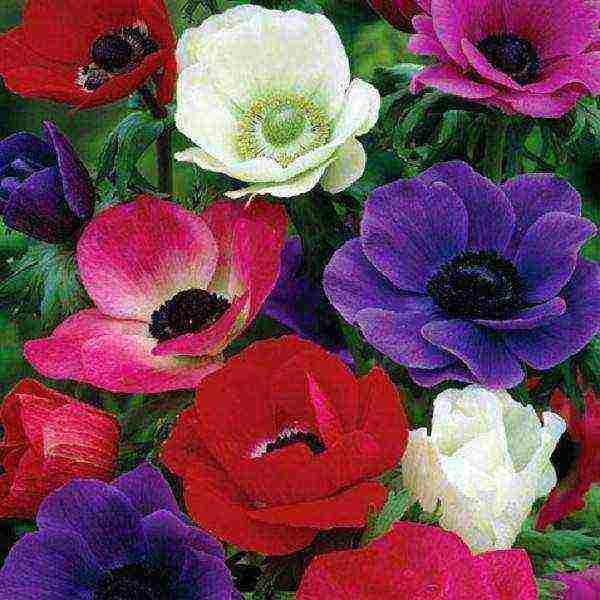
Soil preparation
Digging is carried out to a depth of 30 cm 2-3 months before planting.
At the same time, fertilizers are applied:
- Organic;
- Potash;
- phosphoric.
The second digging is carried out 1-2 weeks before planting the plants, applying nitrogen fertilizers.
Application rates per 1 sq. m:
- manure - 5-6 kg per 1 sq. m;
- ammonium nitrate - 45 g;
- potassium salt - 45 g;
- superphosphate - 60 g.
In areas where water stagnation is possible, planting is carried out on ridges. The soil on them warms up better and earlier flowering is noted. Ridges twenty centimeters high provide runoff and good drainage. Preparation for planting must be completed 8-10 days before planting.
The soil should be permeable, moisture-consuming, loose, fertile, with a pH of 6.0-7.0.
Preparing tubers for planting
Dry tubers germinate very slowly. To speed up this process:
- They are soaked for a day in water or a solution of potassium permanganate.
- Then incubated for 30 minutes in a 0.4% fungicide solution.
Instead, they are treated with hot water:
- sprouted tubers –30 min. at a temperature of 40 ° C;
- dry - 30 min - at 50 ° C.
However, it is believed that prolonged soaking harms the anemone tubers. They absorb a lot of water, which can lead to decay. Instead of soaking, it is recommended to wrap the tubers with a damp cloth soaked in a solution of stimulants (epin, zircon).
Timing and methods of planting  Anemone tubers
Anemone tubers
Tubers are planted in early spring or autumn (October):
- They are planted with tubers or parts thereof.
- All segments must have one or more eyes.
- Sorting by size is desirable in order to have uniform stands. A thickened planting should not be allowed, as this can lead to thinning and stretching of seedlings, as well as to the development of diseases.
- Planted according to the scheme:
- Tubers 1.0–2.0 cm in diameter - 15 x 20 cm, 30 pcs. for 1 sq. m, embedding depth - 4–5 cm;
- more than 2.0 cm - 20 x 20 cm, 25 pcs. for 1 sq. m, depth - 6-8 cm.
- After planting, the soil is watered.
It is imperative to observe the orientation of the plant when planting. The kidney should be on top.
If it is difficult to determine its location, the tuber is placed "on a barrel". You can't plant him upside down. Seedlings may not appear at all.
Care
The main thing is to ensure regular watering and feeding.
- Moderate watering of the soil is preferable before germination, as excess moisture causes tuber disease.
- during the period from germination to the end of flowering, watering is abundant.
With untimely and irregular watering, thinned weak peduncles develop.
Irrigation water should be warm.
During growth, the anemone responds well to fertilizers applied in liquid form.
From organic fertilizers apply diluted manure (necessarily fermented) - 10 liters per 0.5 sq. m or 10-12 plants.
From mineral fertilizers prepare a 1% solution in the proportion of NPK - 1: 0.6: 1.7. 10 liters of this solution for the same number of plants.
From germination to flowering, they are fed twice a month, during the flowering period no more than once a month.
With a powerful growth of the leaf apparatus, nitrogen fertilizers are not used. Feeding is desirable on warm sunny days.
If the weather is cold during the period of plant growth (below 10 ° C), you can limit yourself to 3-4 dressings:
- after germination - 1;
- during budding - 2;
- in the flowering phase - 3-4.
When carrying out dressings, it is impossible for the solution to get on the leaves. If this happens, the fertilizer is washed off with water.
For optimal air exchange and moisture retention, the soil must be loose and free from weeds throughout the growing season.
Reproduction methods
Seed. The seeds can germinate as soon as they are harvested. The best open field sowing time is October – December. Flowering begins in the second year. With special care, it can bloom in the same year after 7-8 months.
When grown through seedlings:
- sowing is carried out at the end of January in boxes in sandy compost soil, covering the seeds with a layer of earth about a finger thick;
- the boxes are kept indoors at a temperature of 12-15 ° C;
- during the germination period, the temperature is slightly lowered so that the seedlings do not stretch;
- after germination, the anemones are kept in a cool room at a temperature of 3-4 ° C;
- seedlings are regularly watered;
- after picking, the seedlings are grown before planting in open ground in a room with a temperature of 10-13 ° C.
Vegetative... When propagated by seeds, the offspring does not always repeat the characteristics of the mother plant. To preserve decorativeness, anemones are bred vegetatively by dividing the rhizomes.
By the method of division, only 2-3 new plants can be obtained from an annual anemone tuber.
To have planting material in sufficient quantities, accelerated reproduction is used:
- In the phase of 3-4 leaves, the upper part of the tuber is cut off.
- Two weeks later, callus tubercles form on it in a circle.
- Leaves sprout from the callus.
- When the leaves have reached a standard size, the tubers are dug up, cut into 6-8 pieces and planted in pots.
The division is carried out in the spring, as anemones slowly restore the root system.
Major pests and diseases Diseases
- Botrytis (gray rot) caused by a fungus from the genus Botrytis - it affects leaves, stems and flowers. Especially often found indoors, in heavily weedy areas and too dense planting. Control measures - treatment of plants with a 0.2% fungicide solution, compliance with crop rotation, soil disinfection.
- Root rot - causes the fungus Phytophtora cooctorum. The development of this disease is facilitated by high temperatures, heavy waterlogged and poorly drained soils. Plant roots darken, rot and die off. Control measures - dressing the soil, processing the planting material with a fungicide solution.
-
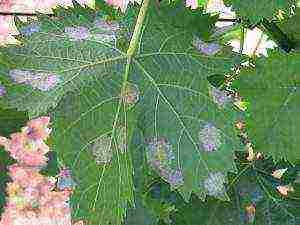
Peronosporosis (downy mildew) Curling the leaves - fungal disease. It affects plants at all stages of development. May cause death. Appears in highly waterlogged areas and quickly spreads when irrigated to neighboring areas. Control measures - treatment of planting material, preventive spraying during the growing season with fungicides.
- Peronosporosis - a fungal disease that causes damage to the leaves from the inside, covering them with a white bloom. The disease occurs at low air temperatures of 4-15 ° C and high humidity. From the leaves it passes to the tuber and roots. Control measures - soil disinfection, observance of crop rotation.
- Rust - affects the leaf, causing it to wrinkle and discoloration. Fungal spores first develop on the underside of the leaf along the edge, then spread to the entire leaf. Control measures - do not grow anemone near cherries, sweet cherries, plums or almonds, remove affected plants, spray with a fungicide solution.
- Viral diseases - damage to plants occurs through sucking pests or soil nematodes. Mosaic spots appear on the leaves, the plant becomes depressed, and often dies. Control measures - adherence to agricultural cultivation techniques, culling of diseased specimens and their destruction.
Pests 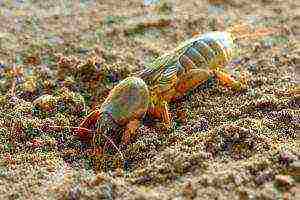 Medvedka
Medvedka
Pests of anemones include aphids, slugs, scoops, field mice, leaf bugs, nematodes, bear.
Green aphids - especially often appear in conditions of high humidity-Control measures: insecticide treatment.
Caterpillars damage mainly seedlings, as well as leaves, buds and flowers of an adult plant.
Slugs damage anemone seedlings in greenhouses and garden beds. Control measures: manual collection, placement of baits.
Agro-measures to reduce the risk of the spread of pests and diseases:
- timely removal of plant waste;
- compliance with the regime of watering and loosening;
- optimal plant density;
- observance of crop rotation
- a balanced diet with a moderate nitrogen content.
- destruction of pests - carriers of viruses.
Preparing for winter
In the fall, with the onset of night frosts, the tubers are dug up, well shaken off the soil and dried. In dried tubers, the ends of the roots and stems are cut off, but so as not to damage the growth buds.
The tubers are stored in a dry room at a temperature of 6 to 10 ° C. At the end of April, they are planted one at a time in pots, and from there into the ground.
Can be planted in the ground without first growing in pots, and also leave the roots in the soil for the winter. In the case of wintering plants in open ground, they need shelter, since freezing is possible.
Types and varieties
Crowned anemone varieties are divided into two groups:
In total, there are more than 150 types of anemones.
They are classified according to the type of root system.
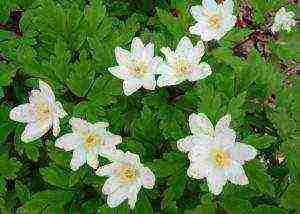 Anemone oakravnaya
Anemone oakravnaya
Long rhizomes blooming in spring:
- oak anemone;
- buttercup;
- Ural;
- Altai;
- smooth;
- blue;
- perm
- Udi.
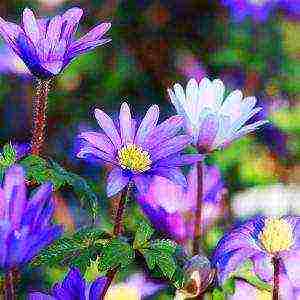 Apennine anemone
Apennine anemone
Having tuberous rhizomes:
- anemone of the appennine;
- Caucasian;
- crown;
- tender;
- garden;
- sparkling.
Autumn species are allocated in a separate group:
- Japanese anemone;
- Hubei;
- hybrid;
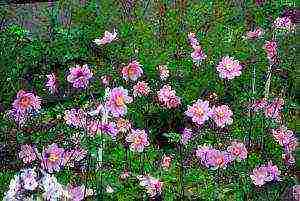 Japanese anemone
Japanese anemone - felt.
And these are far from all varieties of anemones. They are all beautiful and decorative. But among them it still stands out crown anemone, which is grown not only in flower beds, but also to obtain beautiful bouquets and forcing in closed ground.
Other records about anemones
Anemones are graceful herbaceous plants that captivate with a variety of colors and shapes of buds. These perennials look spectacular when surrounded by other flora and stones. They are able to decorate with their presence any garden ...
A question from our subscriber: I bought anemone tubers and now I don't know if it can be planted in the fall (I live in Western Siberia). Or still wait for spring, as you advise?
At the very beginning of my passion for floriculture, I saw luxurious bright flowers in the picture and promised myself to grow the same ones! What kind of anemone do you think the beginner grower liked? That's right, the crowned anemone (Anemone coronaria)….
Hello, please tell me how to grow a beautiful anemone from a dry tuber?
I would like to know exactly how to grow Bridget's anemones?
Hello.When can anemone tubers be immediately planted in open ground? When to expect flowering? Thanks.
See all materials
about anemones :
See all
Anemone is an unpretentious flower native to the Northern Hemisphere. Her name translated from Greek means "wind" or "daughter of the winds". The name is connected with the peculiarity of the flower - its cut leaves and petals succumb to the slightest breath of wind and sway under its influence. They attract attention not only due to the beautiful flowers, but also to a kind of dance to the music of the wind. That is why the plant is usually called Anemone or Chickenpox.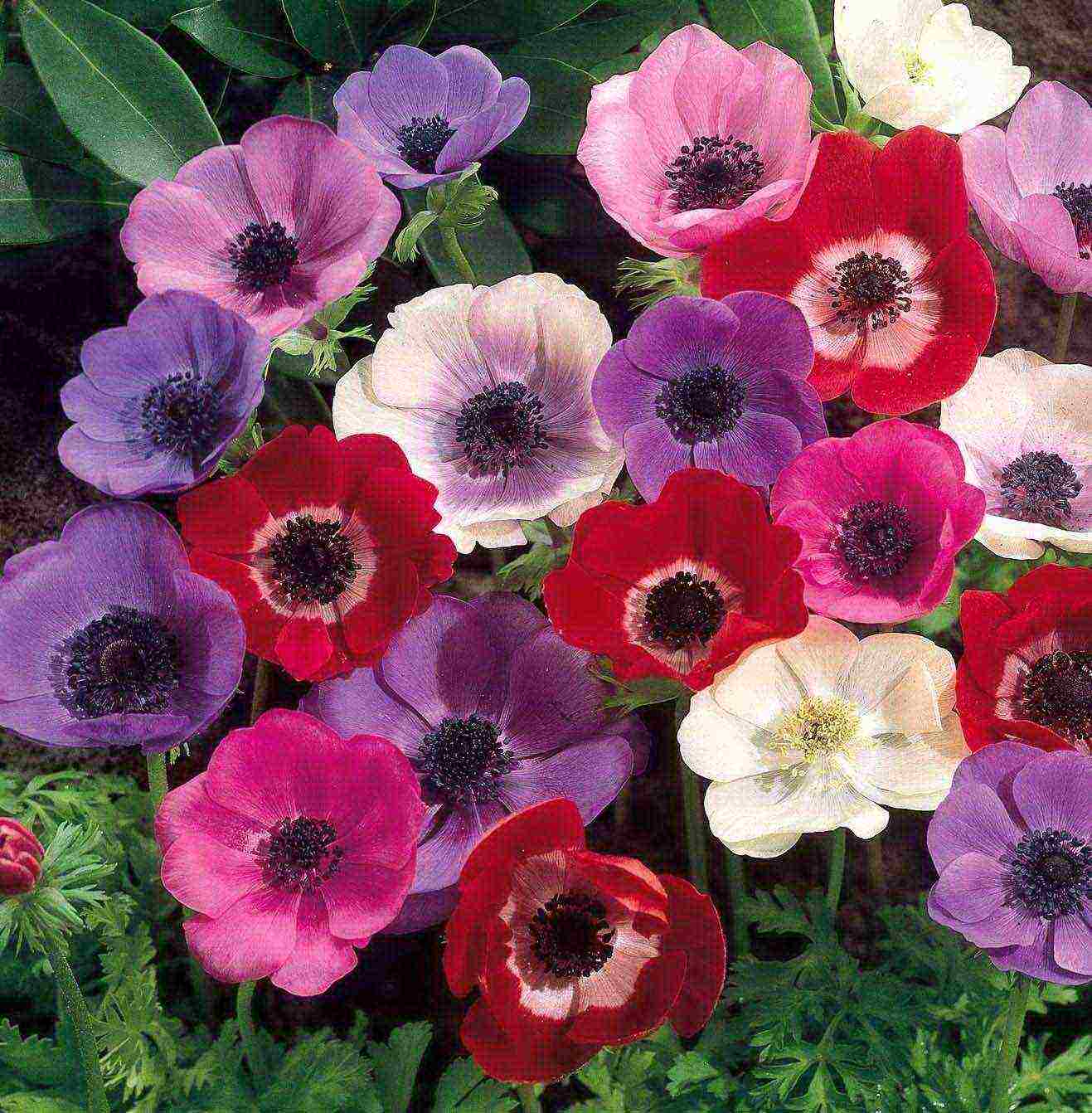
Description of anemone flower
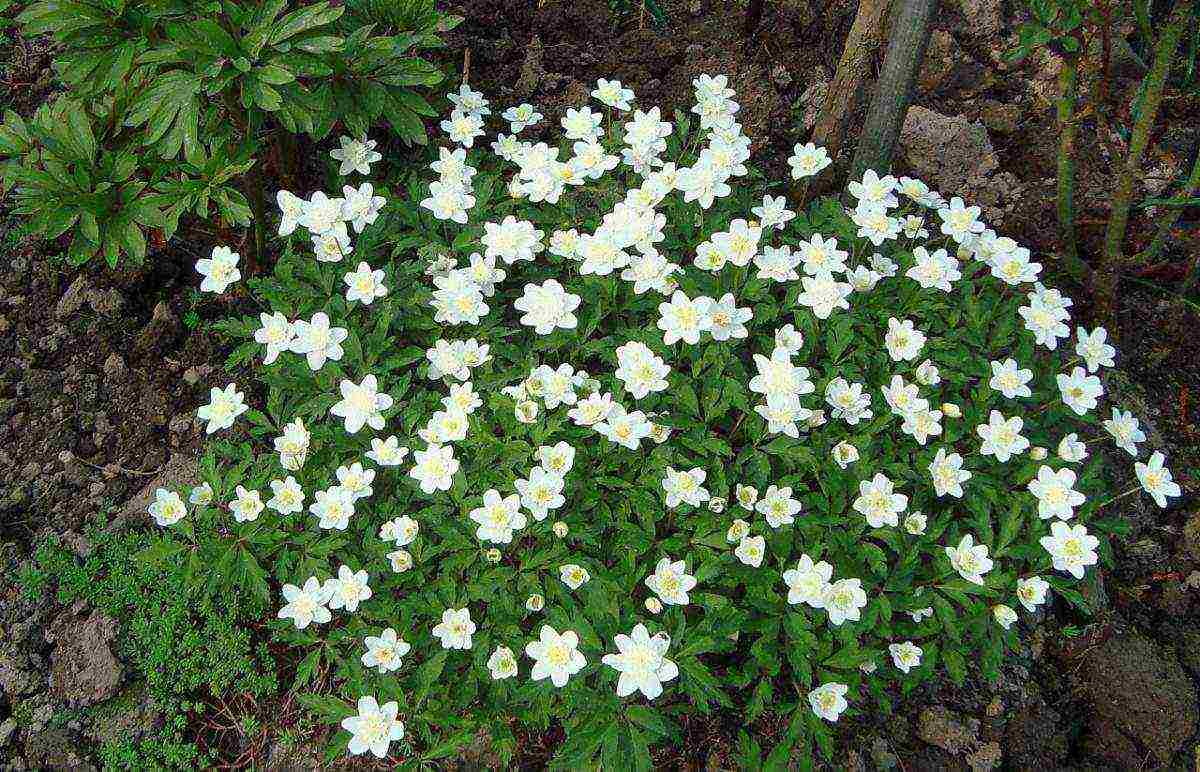 The flower belongs to the Buttercup family, found in temperate climates. Due to its cold resistance, windmill grows in nature even in regions close to the arctic. The plant belongs to primroses, most of its varieties bloom in spring, most often in May.
The flower belongs to the Buttercup family, found in temperate climates. Due to its cold resistance, windmill grows in nature even in regions close to the arctic. The plant belongs to primroses, most of its varieties bloom in spring, most often in May.
It is very difficult to give an unambiguous description of a flower, since it is diverse in everything: the shape and color of petals and leaves, the structure of the stems and root, the distribution area, the flowering period. Look at the article about growing alstroemeria flowers at their summer cottage.
What does a flower look like?
 As a rule, the root system of the anemones is shaped like an elongated cylinder, or can form tubers. The leaves do not grow from the root, but are attached with petioles on the stem. For the most part, they are dissected into several segments.
As a rule, the root system of the anemones is shaped like an elongated cylinder, or can form tubers. The leaves do not grow from the root, but are attached with petioles on the stem. For the most part, they are dissected into several segments.
Flowers are arranged on peduncles singly or collected in umbellate or semi-umbellate inflorescences. Depending on the type and variety, the flowers can be large or small. They consist of a different number of petals - from 5 to 20. They are simple or double. Their color scheme also pleases with a variety of shades: green, purple, yellow, red (for example, Governor), white, pink (for example, Serenade), blue - all these tones are found in the color of Anemone.
Types and varieties of culture
To date, botanists have identified about 170 plant species, and they already include many varieties.
When choosing a variety for your own garden, you need to carefully study its varietal characteristics. Indeed, the success of growing a flower depends on how correctly the variety is selected. Although in most cases, planting anemones and caring for them is not particularly difficult. To make the right choice and not be disappointed with the result, you should know the features of a particular type of flower. What are the anemones and how to properly care for them?
Japanese anemone - elegant and bright
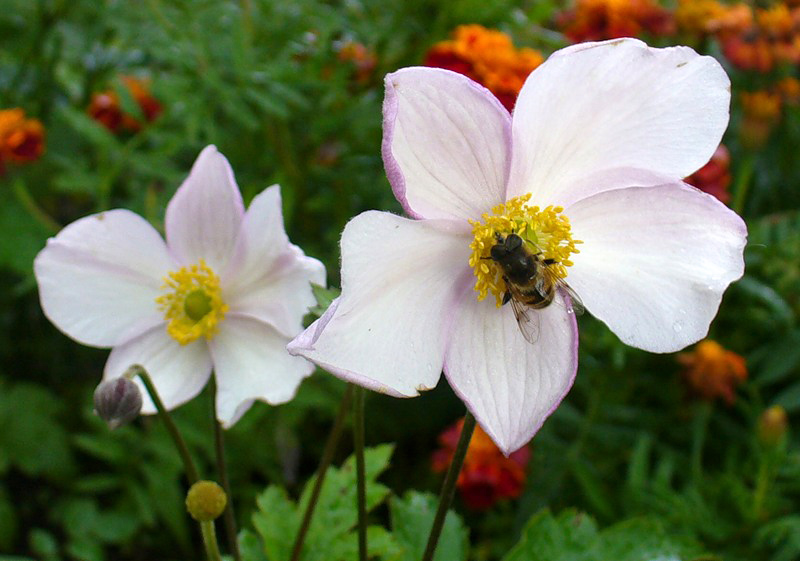 Many varieties that differ from each other are included in the Japanese anemone species, so it is impossible to give a standard description for it. But there are several characteristic features that unite all anemone in one group - Japanese. First of all, it is a tall stem that grows up to 1 m. Moreover, it does not bend as it grows and does not require a garter or support. The shoots have bright, juicy green foliage. It blooms at once with several arrows coming out of the center of the plant. Flowers with a yellow center are bordered by petals of various shades.
Many varieties that differ from each other are included in the Japanese anemone species, so it is impossible to give a standard description for it. But there are several characteristic features that unite all anemone in one group - Japanese. First of all, it is a tall stem that grows up to 1 m. Moreover, it does not bend as it grows and does not require a garter or support. The shoots have bright, juicy green foliage. It blooms at once with several arrows coming out of the center of the plant. Flowers with a yellow center are bordered by petals of various shades.
Japanese varieties
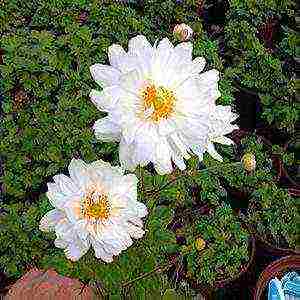 Conventionally, all varieties of this type are divided into three groups. The first is represented by the snow-white variety Whirlwind or, as it is also called, the hybrid Velvind anemone - it is a rather tall plant, its growth reaches 0.8-1 m. Near the roots are green, large, trifoliate, carved leaves with jagged edges. Flowers are a real decoration of a plant. They are quite large, the diameter of each is 6-8 cm. Collected in inflorescences of 14-15 pieces. The central part of the flower is golden yellow, surrounded by snow-white petals. Such anemones bloom in autumn or late summer.
Conventionally, all varieties of this type are divided into three groups. The first is represented by the snow-white variety Whirlwind or, as it is also called, the hybrid Velvind anemone - it is a rather tall plant, its growth reaches 0.8-1 m. Near the roots are green, large, trifoliate, carved leaves with jagged edges. Flowers are a real decoration of a plant. They are quite large, the diameter of each is 6-8 cm. Collected in inflorescences of 14-15 pieces. The central part of the flower is golden yellow, surrounded by snow-white petals. Such anemones bloom in autumn or late summer.
The second group of Japanese anemones includes such hybrid varieties as: Jobert, September Charm, Queen Charlotte, Profusion.The last of these is very rare. It fully justifies its name, because "profusion" means "abundance, wealth." Looking at the flower of a bright, purple flower with velvety-silky petals, one can say that this is a real luxury for any garden. Like the Whirlwind variety, this autumn anemone, its flowering lasts from the first days of August until the cold snaps in October. A highly growing variety, the stems stretch up to 1-1.2 m.
The third group of Japanese anemone - red or Hubei - combines two varieties of Japanese anemones: Prince Henric and Pamina. The Pamina variety is widely known among lovers of this plant. Blooms from the second half of July. The plant is of medium height, does not exceed 1 meter, abundantly blooming with red or beetroot lush inflorescences.
Crown anemone
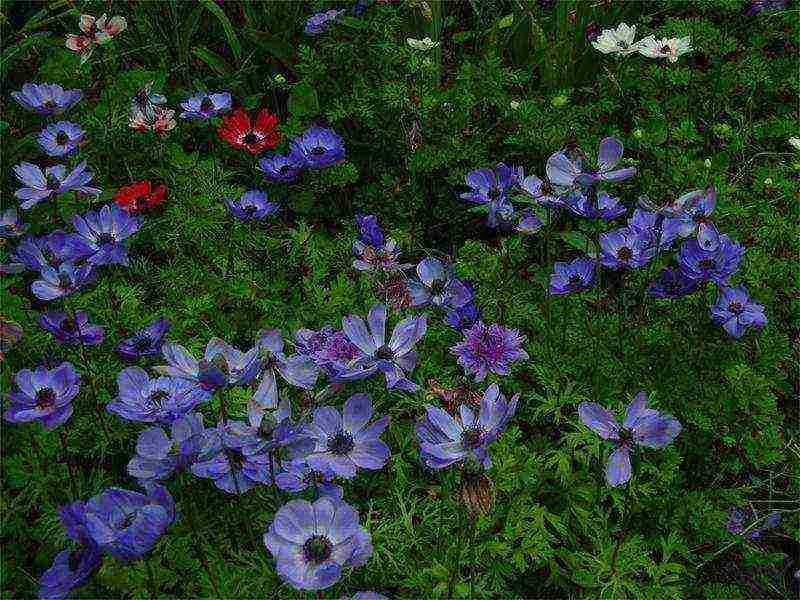 This species is a perennial characterized by the formation of tubers. The plant does not differ in tall stems, its growth does not exceed 30 cm. Flowers vaguely resemble poppies. Their diameter varies from 3 to 10 cm. Each flower consists of 5-6 saucer-shaped petals. Inside there is a dark core composed of numerous dark-colored stamens and pistils. The petals themselves can be simple, double and semi-double. The colors are varied: white, purple, pink, indigo, pale yellow.
This species is a perennial characterized by the formation of tubers. The plant does not differ in tall stems, its growth does not exceed 30 cm. Flowers vaguely resemble poppies. Their diameter varies from 3 to 10 cm. Each flower consists of 5-6 saucer-shaped petals. Inside there is a dark core composed of numerous dark-colored stamens and pistils. The petals themselves can be simple, double and semi-double. The colors are varied: white, purple, pink, indigo, pale yellow.
This species laid the foundation for the popular varieties - Hollandia, Mr. Fokker, The Governer, The Admiral, De Caen, St. Brigit. The last three are most loved by gardeners for their unusually beautiful flowers, versatility and unpretentious care. They will be discussed below.
De Caen - a mix of colors and shades
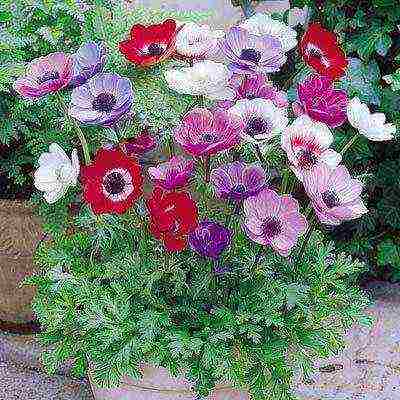 One of the first among all representatives of its kind, the buds of the de Caenne anemone dissolve - its flowering begins with the arrival of summer. In the middle of the hot season, it stops blooming, its leaves die off. But with the arrival of autumn, foliage blooms again, inflorescences with beautiful, multi-colored flowers are thrown out.
One of the first among all representatives of its kind, the buds of the de Caenne anemone dissolve - its flowering begins with the arrival of summer. In the middle of the hot season, it stops blooming, its leaves die off. But with the arrival of autumn, foliage blooms again, inflorescences with beautiful, multi-colored flowers are thrown out.
Even a novice gardener will grow such a flower - caring for the Kaen anemone does not require a special investment of time and knowledge of specific maintenance techniques. Flowers are simple in structure, but they come in a variety of shades - blue, red, white, yellow. Therefore, they are often sold in sets, the names of which often contain the prefix "mix". It means that the set of planting material includes flowers of different shades. Having blossomed, they form a whole flower rainbow.
In many ways, the key to success in growing this species is the correct planting of the de Caen Mix anemones: she does not like the directly directed rays of the sun. Therefore, it is better to plant it in partial shade. Despite its "windy" name, it prefers to grow in places that are well protected from the effects of drafts.
Saint Bridget - terry splendor
The anemone Saint Bridget, a spring-flowering perennial plant with double flowers of various shades, can boast of no less spectacular appearance. They can be blue-blue, crimson-red, white, pink-lilac. Their height is small - about 40 cm. They can be planted as an intermediate option between spring and summer flowers. They will perfectly fill the gap that arises in the flowering of spring and summer garden plants.
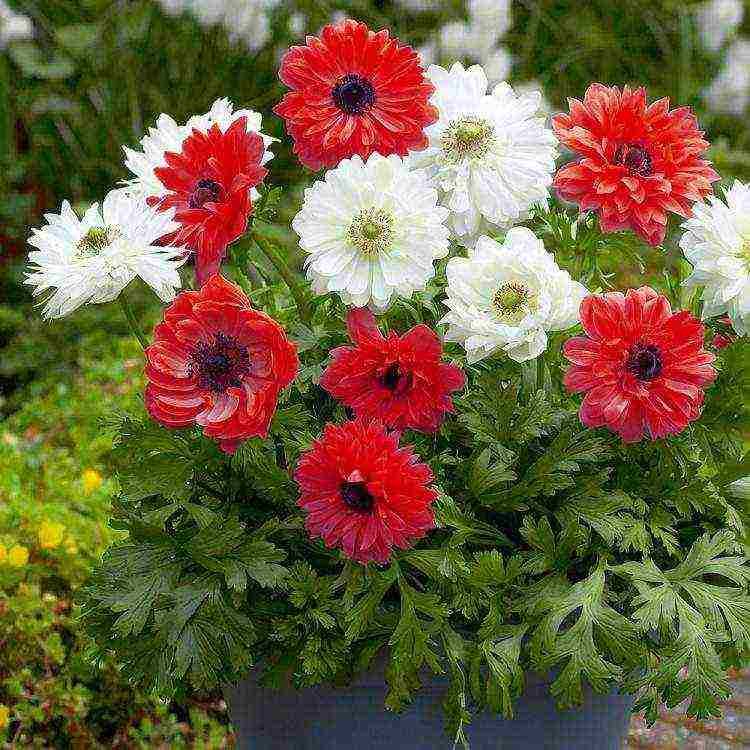 Not only in open ground is it possible to plant Bridget's anemones, such an oak anemone will perfectly decorate verandas, balconies, window sills and loggias. In order to achieve a longer flowering, the bulbs can be planted in a "conveyor way", with an interval of two weeks.
Not only in open ground is it possible to plant Bridget's anemones, such an oak anemone will perfectly decorate verandas, balconies, window sills and loggias. In order to achieve a longer flowering, the bulbs can be planted in a "conveyor way", with an interval of two weeks.
The flower grows very quickly in flower beds, so it needs to allocate a large piece of land if it grows without digging out bulbs for the winter. Indeed, in 2-3 years it is able to occupy an area of 1 sq. All the complexity that is fraught with the care of the bulbous anemone Saint Bridget - for the winter it requires a good shelter.If the region is characterized by long, too cold winters, then it is better to dig up the plant bulbs for storage.
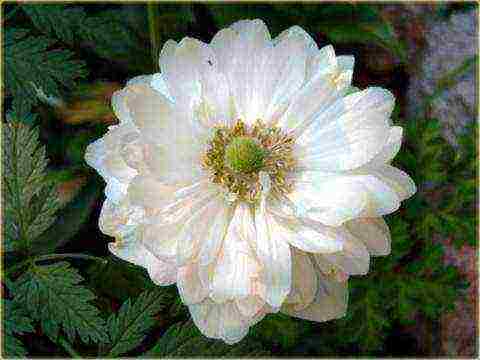 Mount Everest - the whiteness of the mountain peaks
Mount Everest - the whiteness of the mountain peaks
One of the most common varieties of St. Bridget's species is the Mount Everest anemone, adorned with snow-white caps, like the famous summit of the earth - Mount Everest. Outwardly, it resembles two flowers at once - an aster and a dahlia. Its terry petals are snow-white in color, together with a core of light green pistils and stamens, form large flowers up to 10 cm in diameter. Stems of medium height - 30 cm, slightly pubescent. Suitable for spring, autumn planting, as well as indoor cultivation.
Admiral's grade
 The most beautiful terry inflorescences with a lilac shade of petals and a dark, brownish center can please the Admiral anemone not only in the garden, but also in apartment conditions. In addition, like many other varieties of this plant, the admiral's flower is perfect for forming bouquets. Another plus: by planting it in flowerpots on September days, you can achieve flowering of colorful inflorescences at home in the winter.
The most beautiful terry inflorescences with a lilac shade of petals and a dark, brownish center can please the Admiral anemone not only in the garden, but also in apartment conditions. In addition, like many other varieties of this plant, the admiral's flower is perfect for forming bouquets. Another plus: by planting it in flowerpots on September days, you can achieve flowering of colorful inflorescences at home in the winter.
The variety does not belong to tall ones, on average its height is 20-25 cm, the flower is large in diameter - 7-8 cm.It blooms in spring or autumn, depending on when the anemone bulbs were planted in uncovered soil. Can be planted in containers for home growing all year round.
In open soil conditions, it prefers to grow in slightly shaded areas without exposure to drafts. Cold resistance is low, therefore, in the fall, before the onset of cold weather, its bulbs are covered or dug up.
Delicate creation
The Blanda mix or Tender anemone is distinguished by its small size. Its bushes do not exceed 15 cm. This species is early, the flowering period is spring, starting in April. By summer, it stops forming buds, the leaves dry out and die off. The stems of this variety are covered with a "edge", the leaves are dark green in color. The delicate anemone blooms with blue, lilac-pink, blue, white flowers, consisting of 12-15 petals.
Blue Shades is the most delicate of the gentle
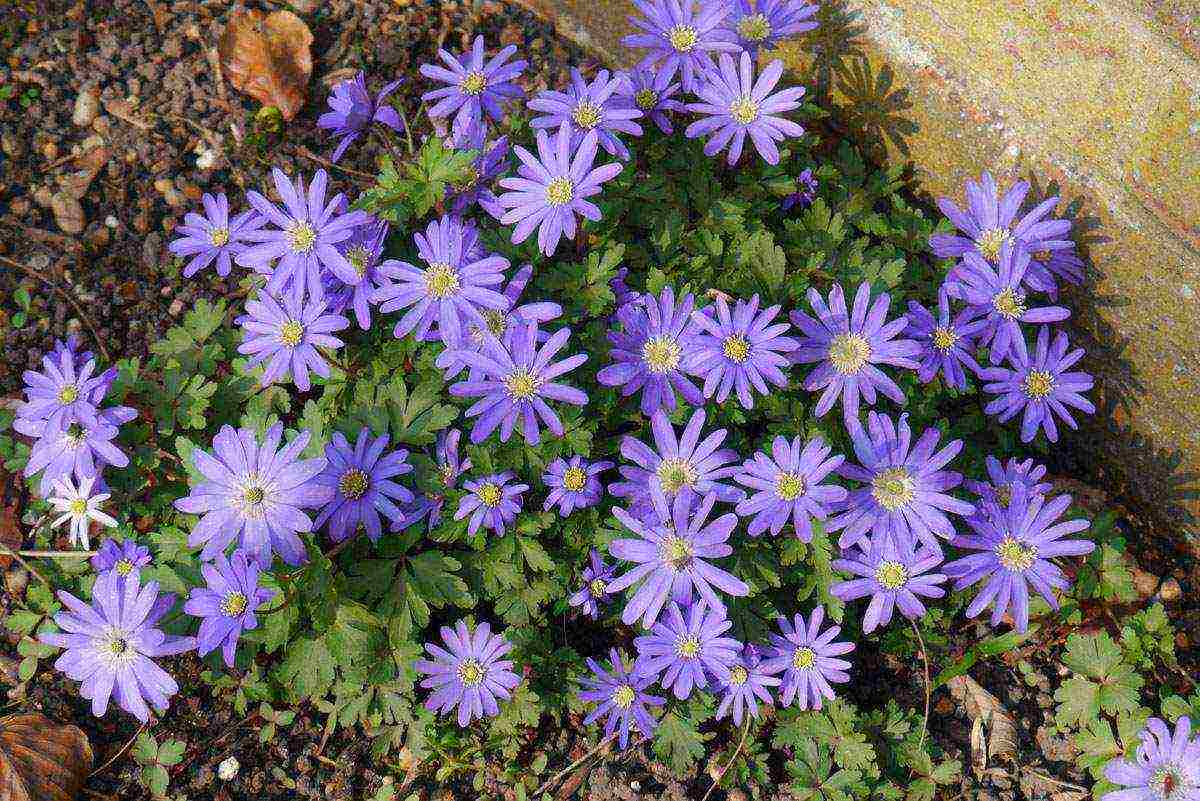 The most unpretentious "character" and delicate "appearance" is characterized by the Blue Shades anemone with flowers very similar to chamomile. It appears almost immediately after the snow melts from the ground. Its flowers, painted in the most delicate light blue color with a purple tint, are capable of blooming for three weeks, sometimes for a month. Like all representatives of the tender anemone, the Blue Shades variety is notable for its small stature. Its height varies from 5 to 10 cm.
The most unpretentious "character" and delicate "appearance" is characterized by the Blue Shades anemone with flowers very similar to chamomile. It appears almost immediately after the snow melts from the ground. Its flowers, painted in the most delicate light blue color with a purple tint, are capable of blooming for three weeks, sometimes for a month. Like all representatives of the tender anemone, the Blue Shades variety is notable for its small stature. Its height varies from 5 to 10 cm.
By the end of spring, the leaves of the primrose wither, and by summer, no stems or leaves of the plant can be found on the surface of the earth. Grows well in any well-drained soil, especially where sand is included. Easy to care for, capable of rapid growth. Literally a few years after planting, it forms a whole blanket of blue-lilac, small flowers.
Bicolor anemone
 The Bicolor anemone is unusually beautiful, its flower is painted in two colors at once, as the name of the plant indicates. Outside, the petals are snow-white, closer to the base - red-coral. The central part is dark. The flowers are large, their diameter is 5-7 cm. They grow well in partial shade.
The Bicolor anemone is unusually beautiful, its flower is painted in two colors at once, as the name of the plant indicates. Outside, the petals are snow-white, closer to the base - red-coral. The central part is dark. The flowers are large, their diameter is 5-7 cm. They grow well in partial shade.
The spectacular appearance of the flower will help to decorate any garden. Moreover, flowering takes place at a time when the spring flowers have already showered the petals, and the summer ones have not yet blossomed. The height is small - 25-30 cm, which allows them to be grown not only in flower beds, but also on window sills, loggias and balconies.
Variety Lord Lieutenant
Flowers with a rare color include the anemone Lord Lieutenant - a spring, bulbous flower with azure blue flowers with a purple tint. They are very large, their diameter reaches 6-6.5 cm. Many petals form the double structure of the flower.An excellent option for drawing up flower arrangements, since it is extremely difficult to find a flower of this shade, especially with such a beautiful, lush structure. The flowering period takes two weeks or more and begins in April-May. One plant is capable of dissolving more than 10 buds.
Basically, the care of a terry anemone Lord Lieutenant does not require complex techniques and techniques. The variety is unpretentious, not prone to diseases and infections, it is easy to breed it on the site, using the tubers and rhizomes of the plant as planting material.
Sylphide variety
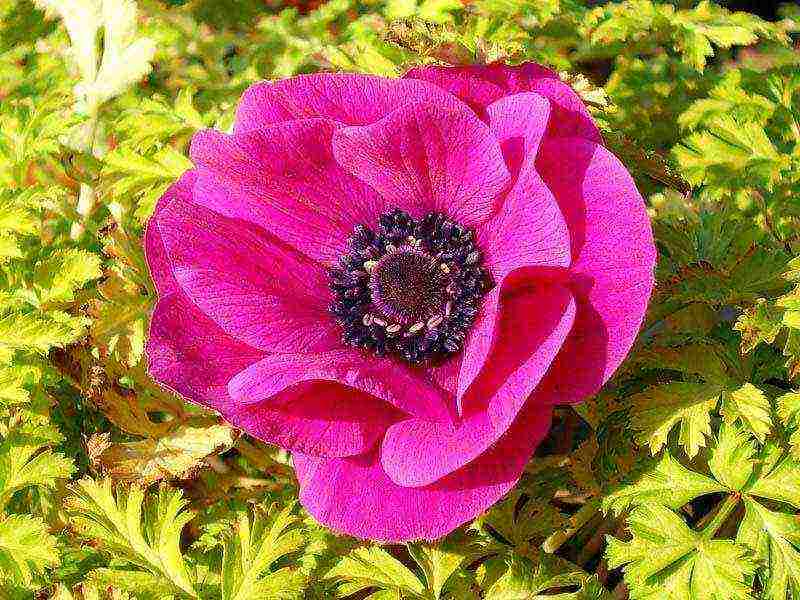 The Sylph anemone has similar characteristics to the Lord Lieutenant variety - it also blooms during April-May. She also has very large flowers, their diameter can be up to 8 cm. She will be a delightful addition to any bouquet, suitable for indoor growing. But she has a completely different appearance. Firstly, the petals are not double, but smooth. Secondly, their color is not blue, but purple.
The Sylph anemone has similar characteristics to the Lord Lieutenant variety - it also blooms during April-May. She also has very large flowers, their diameter can be up to 8 cm. She will be a delightful addition to any bouquet, suitable for indoor growing. But she has a completely different appearance. Firstly, the petals are not double, but smooth. Secondly, their color is not blue, but purple.
The variety belongs to low varieties - the average height of the stems is 20 cm. This allows them to be used as border flowers, as well as for planting in containers to decorate gazebos and verandas. Bright, purple-lilac flowers against a background of green foliage will be a wonderful addition to any mixborder.
Landing rules and care features
Depending on the variety, anemones require different approaches: planting and care in spring and autumn is different.
But there are several general rules that cannot be avoided if a gardener decides to grow a "flower of the winds".
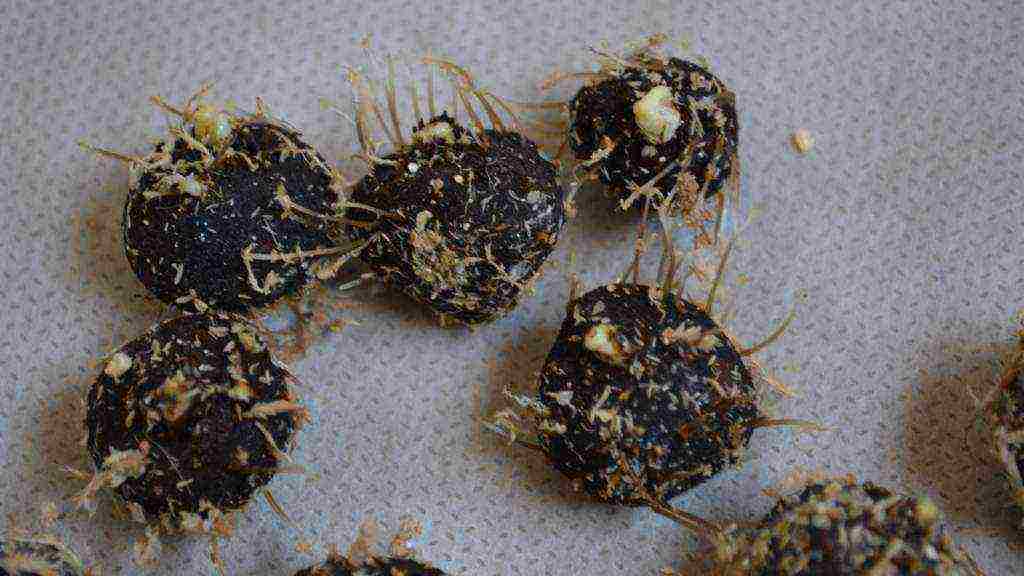 First of all, this concerns the choice of a suitable site, where planting anemone crown, Japanese, Blanda or De Caen will be most appropriate. The most suitable growing conditions are part of the garden land, not blown by a draft and moderately lit by the sun (partial shade is the best option). Although there are plant species that like to grow in areas that are well lit and warmed by the sun's rays. These include the crown, tender, Caucasian and Apennine anemone.
First of all, this concerns the choice of a suitable site, where planting anemone crown, Japanese, Blanda or De Caen will be most appropriate. The most suitable growing conditions are part of the garden land, not blown by a draft and moderately lit by the sun (partial shade is the best option). Although there are plant species that like to grow in areas that are well lit and warmed by the sun's rays. These include the crown, tender, Caucasian and Apennine anemone.
The soil must be drained. Stagnant water can lead to decay of the root system. Therefore, watering is organized in a neat and timely manner. The plant will react negatively to overdriedness, as well as swampy soil.
Soil requirements for plants
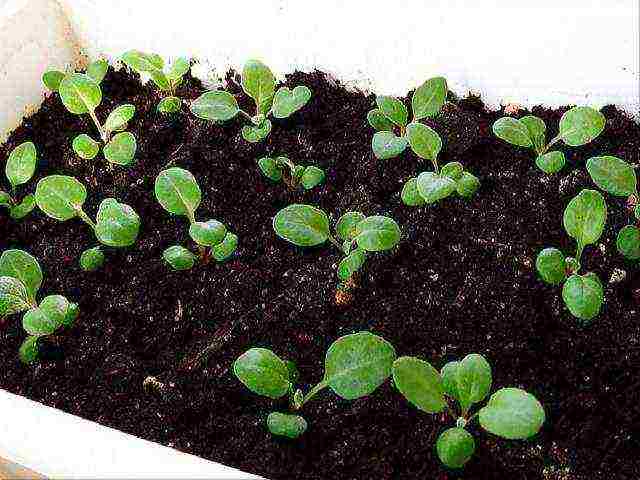 The correct composition of the soil will also affect the care of the hybrid anemone and other flower varieties. In most cases, they are suitable for a neutral soil or with a small acidity indicator. Alkaline soil is suitable only for three representatives of the genus - Caucasian, crown and Apennine.
The correct composition of the soil will also affect the care of the hybrid anemone and other flower varieties. In most cases, they are suitable for a neutral soil or with a small acidity indicator. Alkaline soil is suitable only for three representatives of the genus - Caucasian, crown and Apennine.
It should be remembered that the planting of tuberous anemones is carried out in the ground, the acidity index of which does not exceed 7 units. To reduce the overestimated level of acidity, wood ash is used. It is added to the soil before planting the flower, and the bushes are also sprinkled with ash around the rosette with leaves during growth.
The structure of the soil is not dense, loose, and the composition is nutritious. The optimal conditions for the growth of anemone will be sandy and loamy soils. The main condition for the healthy growth and development of anemones is that the soil must pass moisture well.
Transplanting anemones to a new location
Most varieties do not like transplanting and do not take root well. It is advisable not to expose them to such stress too often. This axiom does not apply to cultivars and varieties that form small root nodules. In this case, the tuberous anemone is planted in a new place every year. When the plant fades, its leaves fall off, the dormancy phase begins, the tubers are dug out. All summer they are stored in a cool room and then planted again, closer to autumn days.
Indoor cultivation of anemones
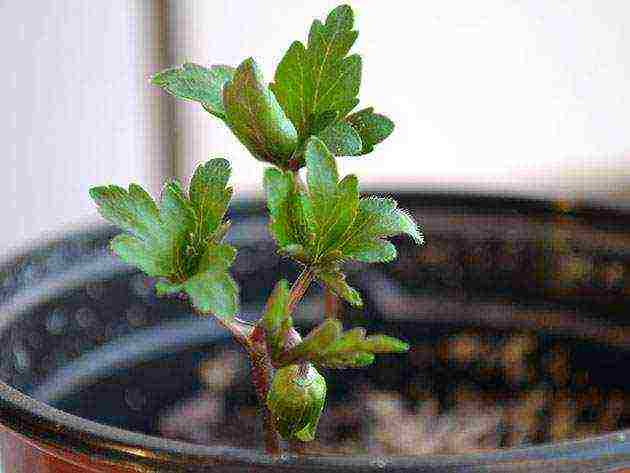 Both on the street and at home, the anemone plant is distinguished by its simplicity in everyday life. Simple planting of anemones at home is carried out using seeds or tubers. If an anemone is planted with seeds, then you must first grow the seedlings in containers with drainage holes filled with nutrient soil. Then the grown seedlings are planted in pots of 4-6 pieces. The flowerpots should be quite roomy so that the anemones are not cramped. Such a joint planting will provide the grower with 100-150 beautiful flowers in a pot, blooming one after another during the entire vegetative period.
Both on the street and at home, the anemone plant is distinguished by its simplicity in everyday life. Simple planting of anemones at home is carried out using seeds or tubers. If an anemone is planted with seeds, then you must first grow the seedlings in containers with drainage holes filled with nutrient soil. Then the grown seedlings are planted in pots of 4-6 pieces. The flowerpots should be quite roomy so that the anemones are not cramped. Such a joint planting will provide the grower with 100-150 beautiful flowers in a pot, blooming one after another during the entire vegetative period.
Growing an anemone from tubers is even easier. All that is needed is to purchase nodules of the required variety and plant them in loose, fertile soil with good drainage at the bottom. Further care completely coincides with the maintenance of garden anemones. You can read the article: Verbena - growing from seeds of the best varieties and hybrids.
,
Anemone (anemone) has a wonderful decorative flowering. Plants are capricious, but not all, require close maintenance in the open field and proper planting. A large number of varieties and a variety of colors have become the reason for immense popularity among gardeners, but it is possible to achieve lush and beautiful flowering only by observing the rules of agricultural technology
1Anemona - planting and care in the open field, photo
Anemones are flowering plants that look great both in single compositions and next to other flowers in flower beds, alpine slides, in ribbon plantings. Planting anemones and caring for them is not always easy and simple, so you should pay attention to some of the nuances when planting seeds and rhizomes, and then take care of them in time.
Anemones by type of root system are divided into two subgroups - rhizome and tuberous... The first species feels great even with inconsistent care, and tuberous anemones require much more attention and with a lack of care, they often die.
anemone - pictured
Anemones are demanding on lighting (partial shade, the flowering period is reduced in the sun), soil acidity and fertility, and the number of waterings per season. Below are a number of rules that must be followed when planting any of the varieties of anemones:
If the variety of purchased flowers is unknown, it is recommended to use this set of rules so as not to destroy the plants. Anemones are demanding on the acidity of the soil - it should be slightly acidic or neutral. In too acidic soil, before planting or transplanting these perennials, lime or dolomite flour should be added.
1.1 Planting seed
Perennials easily reproduce with the help of seeds, but their germination rate is low - usually no more than 25% germinates. To obtain autumn flowering anemone, seeds are planted in March, planted flowers in autumn will bloom in spring or summer and caring for them is not so difficult.
Planting dates vary depending on the climatic conditions of the region - in the spring it is better to plant in mid-late May, and in the fall - in late September - early October.
Some seasoned gardeners plant anemone seeds in the fall, and in this case they do not have to be stratified (kept at temperatures below 0 ° for better germination). Lovers who sow seeds in the spring, be sure to keep them in the refrigerator for some time before planting to increase germination. These rules apply to seeds that were collected from flowers from their own garden, and purchased ones do not require additional stratification. As a rule, the purchased product in the store has already passed all the necessary stages of processing.

anemone seeds - pictured
Anemone seeds should not be buried deep into the ground, weak seedlings are too tender, therefore they cannot always hatch through the upper part of the earth to the light. Sowing should be carried out in loose light soil, you can use peat or river coarse sand. Spread the seed on a well-damp sand or peat surface.Cover with glass or a plastic bag, remove to a warm place with a temperature of +22 ֯ ... + 25 ֯ С.
Anemone seeds germinate 21-35 days after sowing, so don't worry if there are still no sprouts after a week. And yet, propagation of anemones by seeds is a rather rarely used method, it is much easier to grow flowers by a vegetative method.
1.2How to plant an anemone with tubers and rhizomes
Most often, this method is used when transplanting these perennials to a new place. Usually, the procedure for transplanting and dividing rhizomes is carried out in the spring, until the plants begin to grow actively.
When dividing the rhizomes, at least two replacement buds should be left on each division, from which new stems will subsequently grow. Separated rhizomes of anemone should be planted in a previously prepared place. The soil should be loose and nutritious.
Before planting, it is recommended to soak the tubers in a solution of Heteroauxin or Epin (according to the instructions), or simply in warm water so that they swell. It is necessary to plant anemones tubers to a depth of 2-5 cm. A deeper planting can cause tight germination or non-germination (the nodules can rot). This is how the crown spring anemones are planted from purchased tubers, it is the most demanding in terms of care.

preparation of anemone tubers for planting
The tubers are planted with the elongated part down, observing the distance between plantings of 10-16 cm, while the flat part will be directed upwards. Those anemones that reproduce by tubers must be dug up for the winter and stored at home, and the anemones with rhizomes are left in the ground to winter. According to gardeners, it is quite difficult to keep tubers at home, but in mild winters, the nodules remaining in the open field can germinate next year.
Root-sprouting rhizomes (hybrid, Canadian, forest, fork) are recommended to be replanted in the spring. When sprouts appear on the surface of the soil, the roots are dug up and planted in a permanent place.
Propagation of anemones by rhizomes is carried out with cuttings 5-6 cm in length in a previously prepared loose nutritious substrate. Cuttings can be pre-treated with any corn stimulant. You need to plant so that the top of the stalk is visible on the surface. On top, compact the soil mixture with sand, while you need to watch the tops, which should not "fall through".
Moisten from a spray bottle, cover with a plastic bag or a piece of film on top and send to a greenhouse or greenhouse. Water gently and sparingly to avoid rot. The protective film cover should be removed when the first leaves appear. Landing in open ground is carried out the next year.
1.3 Nuances of caring for anemones
It is not difficult to care for anemones in the open field, the main thing is to water perennials on time, avoiding excessive soil moisture. To prevent moisture from evaporating quickly, a layer of mulch is sprinkled around the perennials. They use humus, peat chips, and better - oak litter, linden foliage, apple trees.
Fertilizers for these plants should be applied when buds appear and flowering. Standard complex mineral supplements for flowering plants are usually used. Watering anemones is rarely carried out, in some years you can do without it - this feature of flowers allows them to be planted in hard-to-reach places for water.
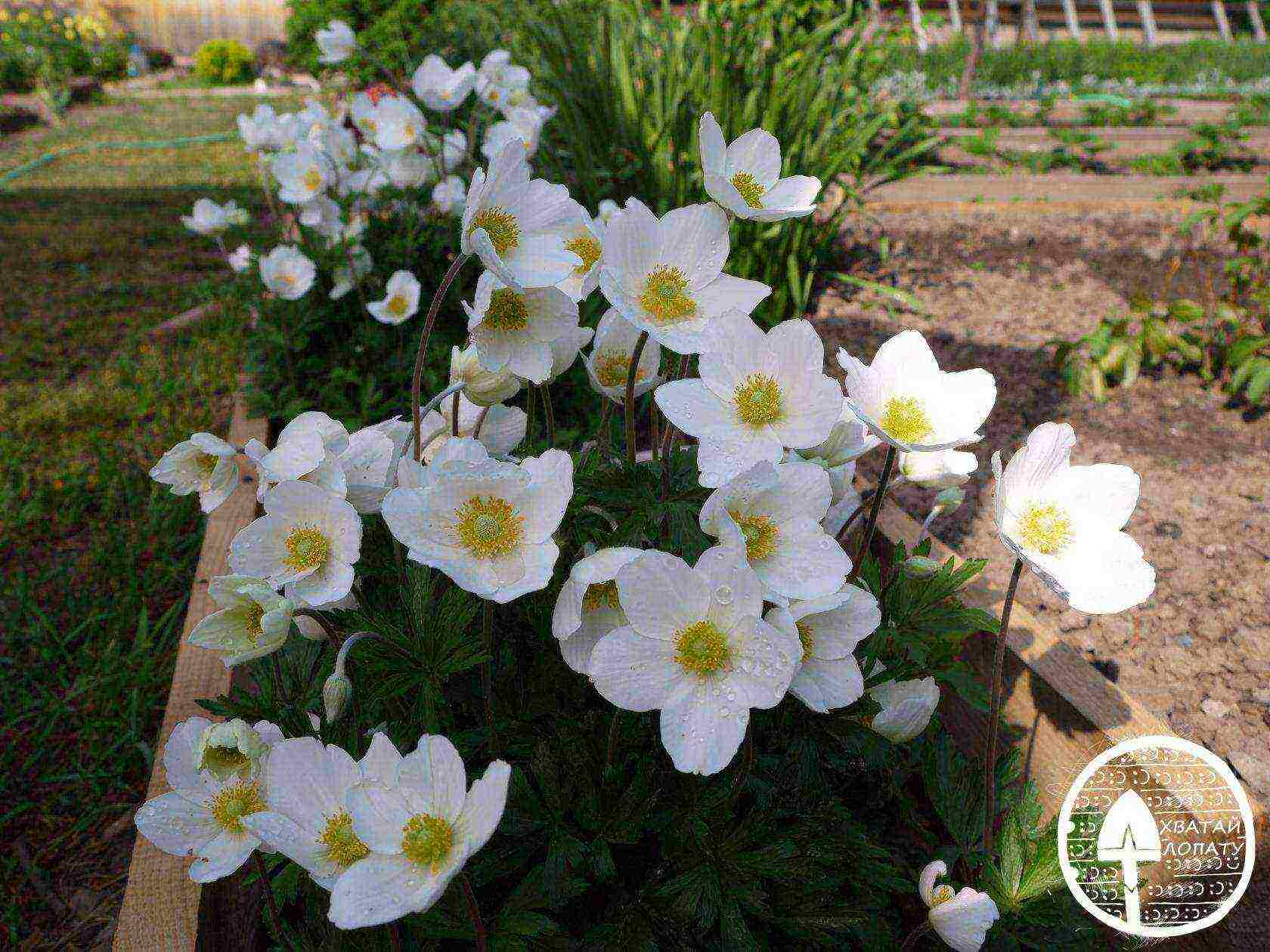
anemone in the garden
For the winter, anemones can be left to winter in flower beds, but not all - it is better to dig the crown out, otherwise it will freeze. Other species are covered with a thick layer of mulching material before the onset of cold weather. It is simple to care for these perennials, the only exception can be anemones with tuberous rhizomes - tender, Apennine, Caucasian.
Successful planting of anemone and good outdoor care will lead to a beautiful bloom.Many gardeners note that unusually beautiful and delicate flowers will decorate any garden and will delight the owners with a rather long flowering.
2 Types and varieties of anemone
This genus has about 150 species of anemone. The height of tuberous and rhizome perennial plants varies from 10 to 100 cm. The color of flowers is varied - blue, white, pink, red, even blue and yellow.
There is a distribution by groups, but autumn plants are subdivided into a separate category (hybrid anemone, Japanese, Hubei, felt). Other types of anemone are classified into groups depending on the type of root system:
- Anemone with long jointed rhizomes - forest plants are represented by single flowers and spring flowering period (Altai, Ural, Golubaya, Udinskaya, Gladkaya, Perm, Lyutichnaya, Dubravnaya);
- anemones with tuberous rhizomes and single flowers (Caucasian, Sparkling, Garden, Crowned, Apennine, Tender);
- long-haired and bunchy anemone (having a thickened short rhizome, vegetating throughout the season);
- Fork, Canadian and Lesnaya - are able to form root suckers.
Among the many species, the crown anemone and the Japanese autumn anemone are the most popular among flower growers in our country. Caring for crown anemone outdoors will require care and attention from flower growers. The most popular tuberous anemone varieties are:
- anemone Lord Lieutenant;
- anemone Governor;
- anemone White Splendor;
- Anemone Sylphides.
Anemones are quite unpretentious flowers that, with their various colors, will decorate any garden plot. If desired, you can make various compositions from anemones and other flowering plants, getting unusual catchy flower beds.
